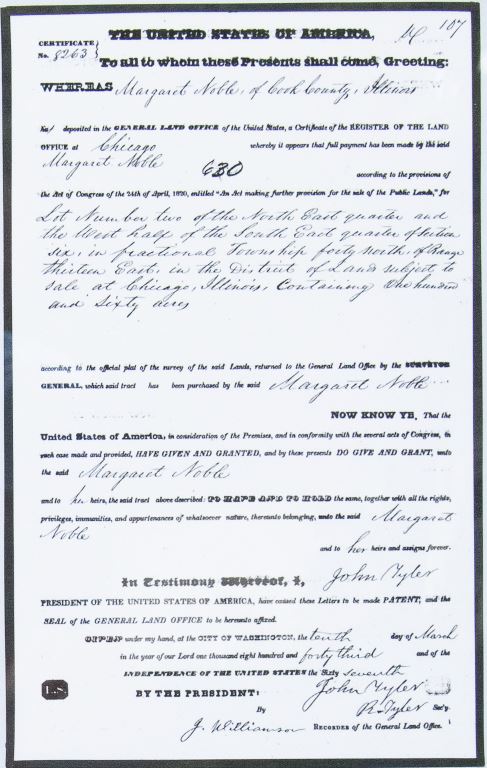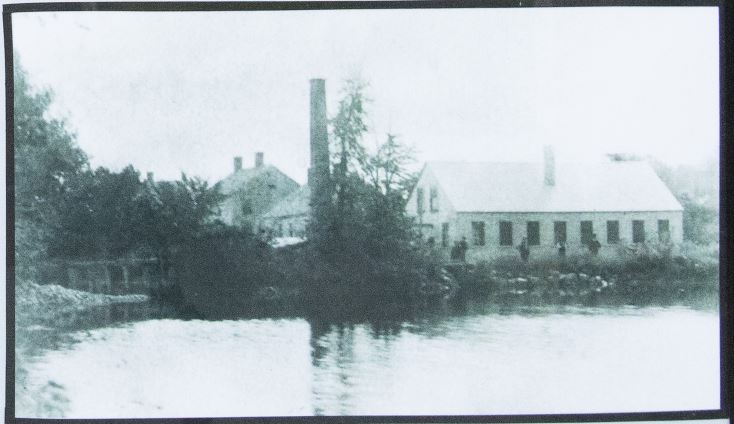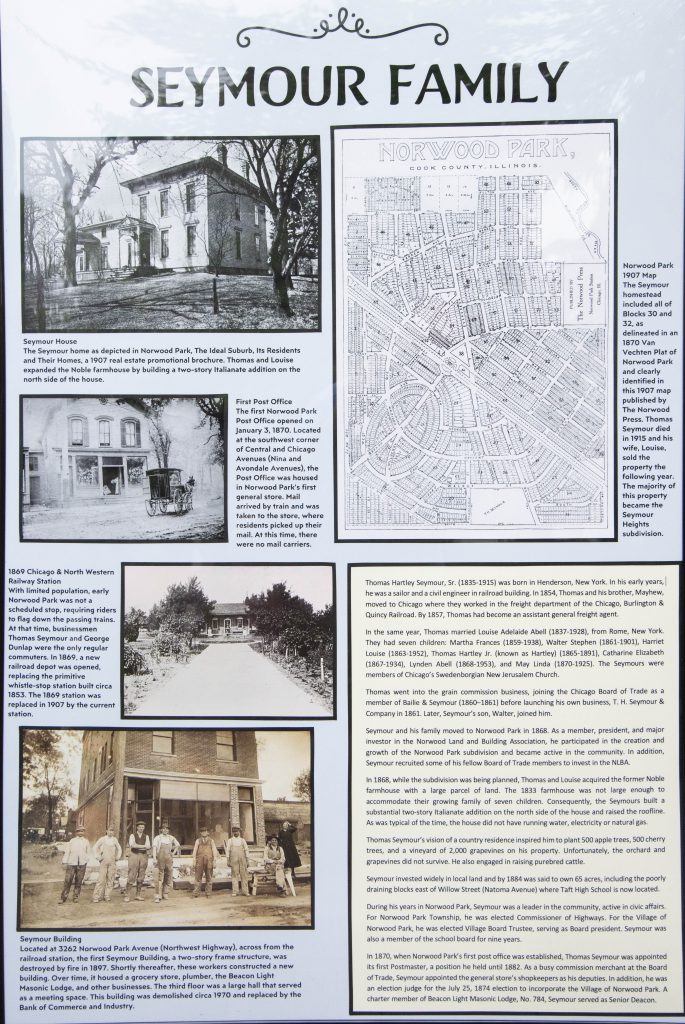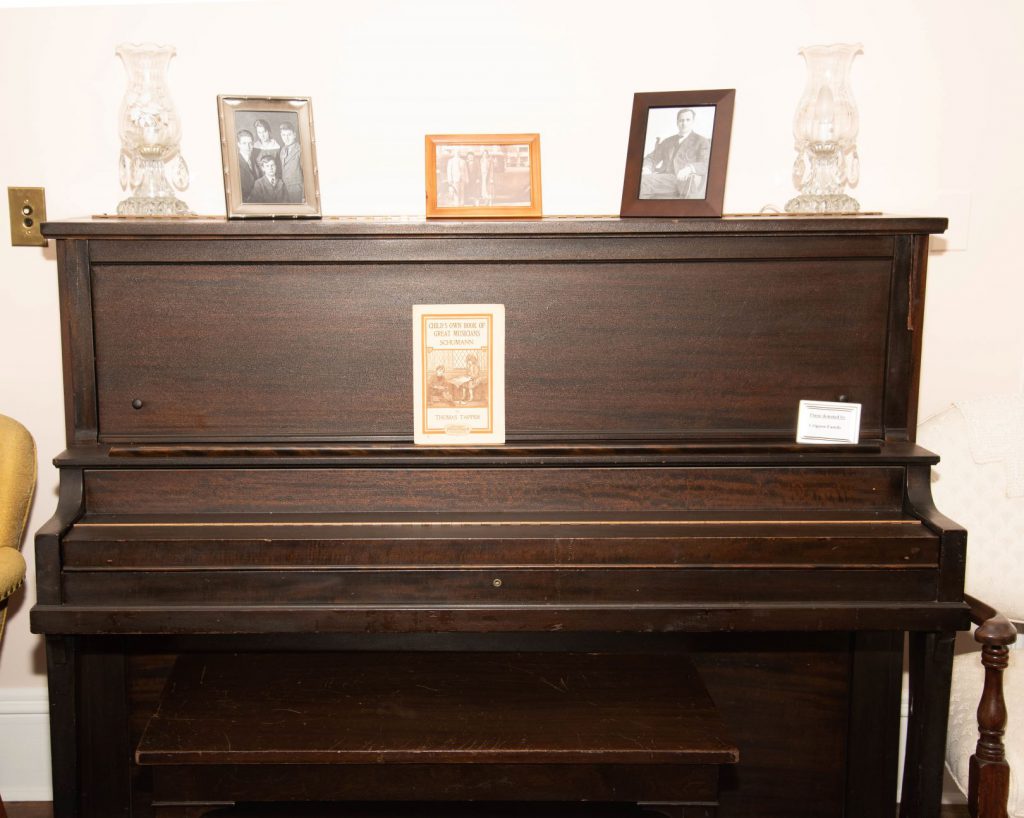The Nobles
Mark Noble Sr. (c 1765-1839) arrived in the Chicago Settlement with his family on August 4, 1831, from their home in Yorkshire, England, with gold currently valued at $725,000. The Chicago Settlement was the small group of people who lived near Fort Dearborn before the Town of Chicago was incorporated (population about 100 people total) in 1833. Initially the Nobles rented John Kinzie’s former home, originally built and occupied by Jean Baptiste Pointe DuSable. Noble chose to diversify his investments by purchasing real estate, raising cattle, and building and operating sawmills. During the Black Hawk War in 1832, the Nobles helped avert a famine by supplying and butchering cattle to feed the settlers sheltered at Fort Dearborn.

In 1833, Mark Sr. and Margaret Noble claimed more than 150 acres in the prairie that would become Norwood Park. They built their home on Union Ridge, a glacial moraine, and became the first non-indigenous residents in the area. Unlike many early farmhouses constructed of logs, the Noble home was constructed of sawn lumber from their Bickerdike-Noble Sawmill. This home is the oldest existing house in Chicago.

Devout Methodists, the Nobles were among the founding members of Chicago’s first Methodist congregation, established in 1831. Mark Noble served as a lay minister and daughters Mary and Elizabeth taught Sunday School. In addition, the Nobles opened their home in Chicago, and later in Norwood Park, to circuit-riding ministers who conducted services and religious classes for local worshipers. In 1838, Mark Noble built a small church on his property, but its exact location remains unknown.
Mark Noble Sr. died on November 25, 1839. Although there is no known record of his gravesite, it is possible his remains were buried on the family’s Norwood Park homestead. In 1849, Margaret Noble sold her home (now the headquarters of the Norwood Park Historical Society) and property and moved to Port Lavaca, Texas, with son, Mark Jr. and his wife, Charlotte. Margaret’s son, John, and his wife, Lucia, remained in Chicago, as did daughter, Elizabeth, and her husband Robert Robinson. Margaret’s daughter, Mary, and her husband George Bickerdike returned to Knaresborough, North Yorkshire, England.
Chicago’s Noble Street was so named to recognize the Noble family contributions to the citizens of Chicago. Click here to see the Noble Family poster.

The Seymours
Thomas Seymour (1835-1915), a prominent member of Chicago’s Board of Trade, and his wife, Louise (1837-1928), bought the former Noble house and adjacent property in 1868. Shortly thereafter, to accommodate their large family and servants, they enlarged the house by building an Italianate addition on the north side of the house. On the property, he raised cattle, cultivated an orchard of apple and cherry trees, and planted a vineyard.
Thomas was a member of the Norwood Land and Building Association (NLBA) and recruited a number of his Board of Trade colleagues to participate. The NLBA purchased a group of farms with the goal of creating a moral, healthy and eautifully landscaped suburban subdivision. This led to the founding of both the Township and Village of Norwood Park in 1874. Seymour served as Norwood Park Postmaster for fourteen years and played a leading role in Norwood Park Village government and civic affairs. After he died, Louise sold the property and moved to Pasadena, California, where she died.

The Crippens
Dramatist Charlotte Allen (1864-1932) met pianist Stuart Crippen Sr. (1872-1961) while both were performers in the theater, marrying in 1899. Subsequent to the death of her brother, Leonard Allen, Charlotte became the owner and operator of the chemical manufacturing company he had founded, L. B. Allen Company. Stuart also joined the company. Despite changing careers, the Crippens’ interest in music and drama continued throughout their lives.
In 1916, the Crippens purchased the former Noble-Seymour House and adjoining property which extended south to Union Ridge Cemetery. Initially, their home was only a summer residence without plumbing or electricity. By 1918, with the addition of these modern conveniences, they made Norwood Park their permanent residence.
In 1927, Charlotte built a new factory at 6719 W Bryn Mawr, south of the family residence, relocating her business within walking distance of her home. Many of her employees were local Norwood Park residents. When construction for the Northwest Expressway (later renamed the Kennedy Expressway) was begun in the late 1950s, the L.B. Allen Company was forced to move and relocated to Schiller Park.
The civic-minded Crippen family sponsored community theater, musical productions, founded the local Little League program, sponsored a reading program at Taft High School, and raised $750,000 for a World War II hospital plane named “The Spirit of Norwood Park.” They were also founding members of the Norwood Park Baptist Church (now Windy City Community Church) and hosted its first services in their living room.
Following the death of Charlotte in 1932, Stuart married Anna Bell Penney Shaw and relocated for a time to Fairhope, Alabama. During the Depression, while Stuart Sr. was living in Alabama, the house was divided into two residences and occupied by Stuart and Charlotte’s two sons, Stuart, Jr. and Paul, and their families.
Agnes Crippen, widow of Stuart Jr., and her children, Nancy Crippen Michener and Stuart C. Crippen, sold the house and the remaining 1.7 acres of land to the Norwood Park Historical Society on December 31, 1987. The Society transformed the residence into its headquarters, museum, archives, and meeting space for educational programs and other events. The Noble-Seymour-Crippen House was designated a City of Chicago Historical Landmark on May 11, 1988 and listed on the National Register of Historic Places on August 10, 2000.

